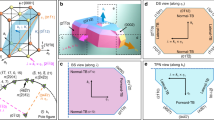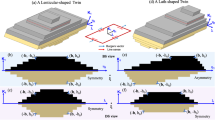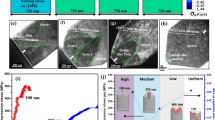Abstract
IN the course of an investigation1 of optically active uniaxial crystals, I expressed the view that the possibility of twinning of a crystal was connected with a definite pseudo-symmetrical character of its structure as a whole. This statement was seriously attacked by Prof. Friedel, as may be clear from the following quotation of his paper:2 “La formation de la macle est totalement indifférente à la symétrie ou à la pseudo-symétrie de l'édifice cristallin ou des groupes d'atomes qui le constituent. Elle est due uniquement à la rencontre de symétries ou de pseudo-symétries dans les périodes (mailles, simples ou multiples) de cet édifice.”
This is a preview of subscription content, access via your institution
Access options
Subscribe to this journal
Receive 51 print issues and online access
$199.00 per year
only $3.90 per issue
Buy this article
- Purchase on Springer Link
- Instant access to full article PDF
Prices may be subject to local taxes which are calculated during checkout
Similar content being viewed by others
References
W. G. Burgers, Proc. Roy. Soc., A, 116, 553; 1927.
"Au sujet d'un Mémoire de M. W. G. Burgers sur les cristaux uniaxes à pouvoir rotatoire", Comptes rendus, 186, 1788; 1928.
Compare, for example, the explanation of some twin structures exhibited by quartz crystals, by Sir W. H. Bragg, and R. E. Gibbs, Proc. Roy. Soc., A, 109, 405; 1925.
W. L. Bragg, Proc. Roy. Soc., A, 105, 16; 1924.
Similar remarks have been made by F. Heide, Z. Krist., 66, p. 225; 1928.
It may be remarked in this connexion that even Prof. Friedel himself, notwithstanding his definite statement about the cause of twinning quoted above, has made similar remarks in other passages of his treatises, as, for example, in "Leçons de crist.", p. 449.
Z. Krist., 80, 355; 1931.
"Leçons de cristallographie", pp. 392–398; compare also Comptes rendus, 182, 741; 1926.
Proc. Roy. Soc., loc. cit., pp.560–561.
Z. Krist., 72, 218; 1929.
See Z. Krist., 73, 147; 1930.
Z. Krist., 74, 20; 1930.
Compare, for example, W. H. Bragg, "An Introduction to Crystal Analysis", (London, G. Bell, 1928, pp.134 and following); also W. T. Astbury, Proc. Roy. Soc., A, 112, 448; 1926.
Author information
Authors and Affiliations
Rights and permissions
About this article
Cite this article
BURGERS, W. Cause of Twinning of Crystals. Nature 129, 363–364 (1932). https://doi.org/10.1038/129363a0
Issue Date:
DOI: https://doi.org/10.1038/129363a0
Comments
By submitting a comment you agree to abide by our Terms and Community Guidelines. If you find something abusive or that does not comply with our terms or guidelines please flag it as inappropriate.



